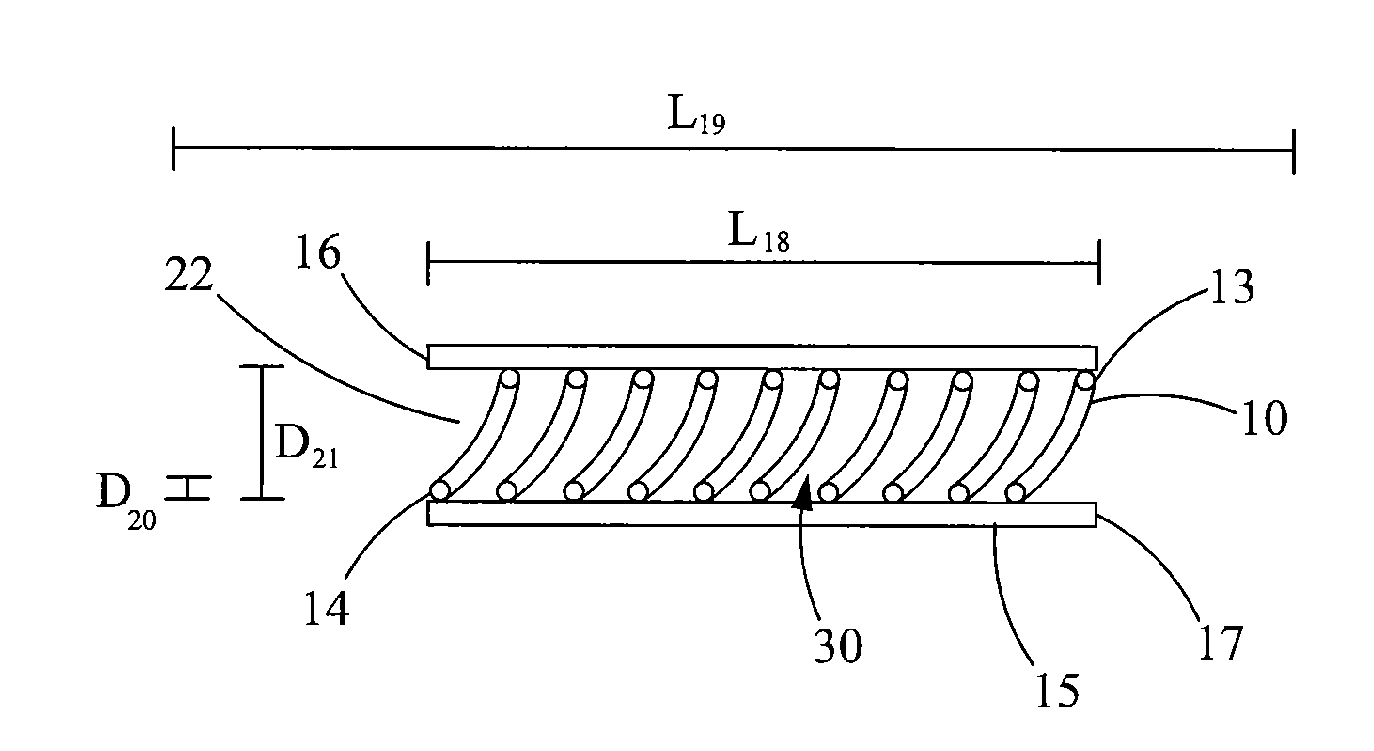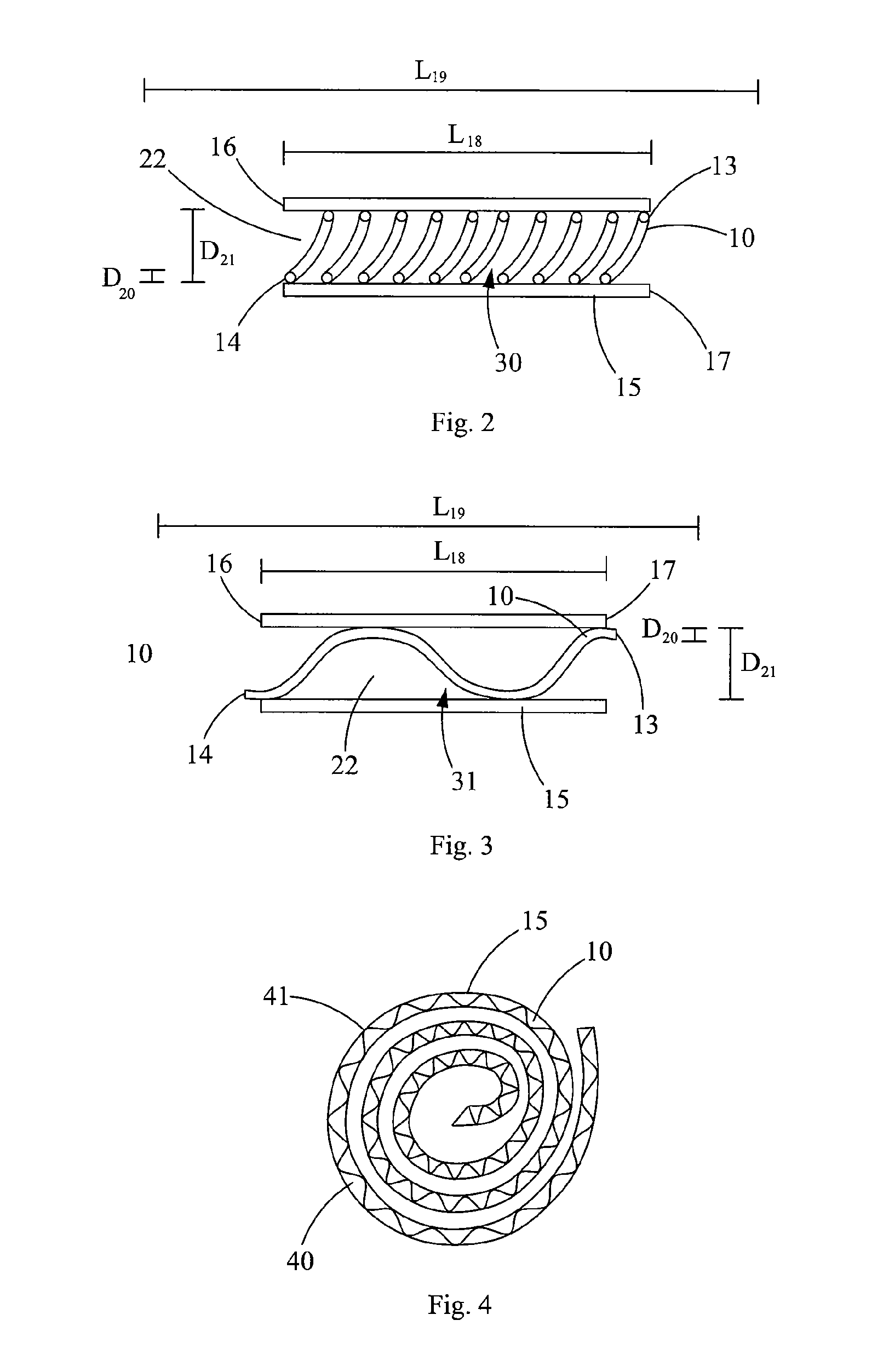Optical fiber configurations for transmission of laser energy over great distances
a technology of optical fibers and lasers, applied in the field of optical fiber configurations, can solve the problems of fiber heating and ultimate failure, failure to deliver high-power laser energy over great distances, and failure to eliminate the phenomenon of stimulated raman scattering (“srs”)
- Summary
- Abstract
- Description
- Claims
- Application Information
AI Technical Summary
Benefits of technology
Problems solved by technology
Method used
Image
Examples
example 1
[0086]Inner radius of the outer protective member, ROPM=1.5 mm (millimeters).
[0087]Outer radius of the fiber (including coating) RF[L]=400 μm (microns).
[0088]Temperature change that the configuration must sustain in the intend use, ΔT [T]=100° C.
[0089]Mechanical strain that configuration must sustain in the intend use, ε=0.0005
[0090]Coefficient of thermal expansion of the fiber, CTEF=0.55*10−6 (1 / C).
[0091]Coefficient of thermal expansion of the outer protective member, CTEOPM=15*10−6 (1 / C).
[0092]Length of outer protective member at ambient temperature and no mechanical strain, LOPM=2 km.
[0093]Minimum bend radius of fiber, RFmin=10 cm.
[0094]Inner radius of a coil (for example of the type shown in FIG. 4) of the configuration, Rcoil=1.5 m.
[0095]Wherein, the AFL[L] for a helical non-following path (for example of the type shown in FIG. 2) is from about 3.89 to about 10.4 m; the AFL[%] for a helical non-following path is from about 0.195% to about 0.517%. Wherein, the AFL[L] for a sinus...
example 2
[0096]Inner radius of the outer protective member, ROPM=3 mm (millimeters).
[0097]Outer radius of the fiber (including coating) RF [L]=250 μm.
[0098]Temperature change that the configuration must sustain in the intend use, ΔT [T]=10° C.
[0099]Mechanical strain that configuration must sustain in the intend use, ε=0.0001.
[0100]Coefficient of thermal expansion of the fiber, CTEF=0.55*10−6 (1 / C).
[0101]Coefficient of thermal expansion of the outer protective member, CTEOPM=15*10−6 (1 / C).
[0102]Length of outer protective member at ambient temperature and no mechanical strain, LOPM=1 km.
[0103]Minimum bend radius of fiber, RFmin=20 cm.
[0104]Inner radius of a coil (for example of the type shown in FIG. 4) of the configuration, Rcoil=1 m.
[0105]Wherein, the AFL[L] for a helical non-following path (for example of the type shown in FIG. 2) is from about 0.245 to about 5.55 m; the AFL[%] for a helical non-following path is from about 0.0245% to about 0.555%. Wherein, the AFL[L] for a sinusoidal non-f...
example 3
[0106]Inner radius of the outer protective member, ROPM=1.6 mm (millimeters).
[0107]Outer radius of the fiber (including coating) RF [L]=100 μm.
[0108]Temperature change that the configuration must sustain in the intend use, ΔT [T]=50° C.
[0109]Mechanical strain that configuration must sustain in the intend use, ε=0.0002.
[0110]Coefficient of thermal expansion of the fiber, CTEF=0.55*10−6 (1 / C).
[0111]Coefficient of thermal expansion of the outer protective member, CTEOPM=26*10−6 (1 / C).
[0112]Length of outer protective member at ambient temperature and no mechanical strain, LOPM=3 km.
[0113]Minimum bend radius of fiber, RFmin=10 cm.
[0114]Inner radius of a coil of the configuration, Rcoil=50 cm.
[0115]Wherein, the AFL[L] for a helical non-following path (for example of the type in FIG. 2) is from about 4.42 to about 18.2 m; the AFL[%] for a helical non-following path is from about 0.147% to about 0.61%. Wherein, the AFL[L] for a sinusoidal non-following path (for example of the type shown in...
PUM
| Property | Measurement | Unit |
|---|---|---|
| power loss | aaaaa | aaaaa |
| radius | aaaaa | aaaaa |
| radius | aaaaa | aaaaa |
Abstract
Description
Claims
Application Information
 Login to View More
Login to View More - R&D
- Intellectual Property
- Life Sciences
- Materials
- Tech Scout
- Unparalleled Data Quality
- Higher Quality Content
- 60% Fewer Hallucinations
Browse by: Latest US Patents, China's latest patents, Technical Efficacy Thesaurus, Application Domain, Technology Topic, Popular Technical Reports.
© 2025 PatSnap. All rights reserved.Legal|Privacy policy|Modern Slavery Act Transparency Statement|Sitemap|About US| Contact US: help@patsnap.com



